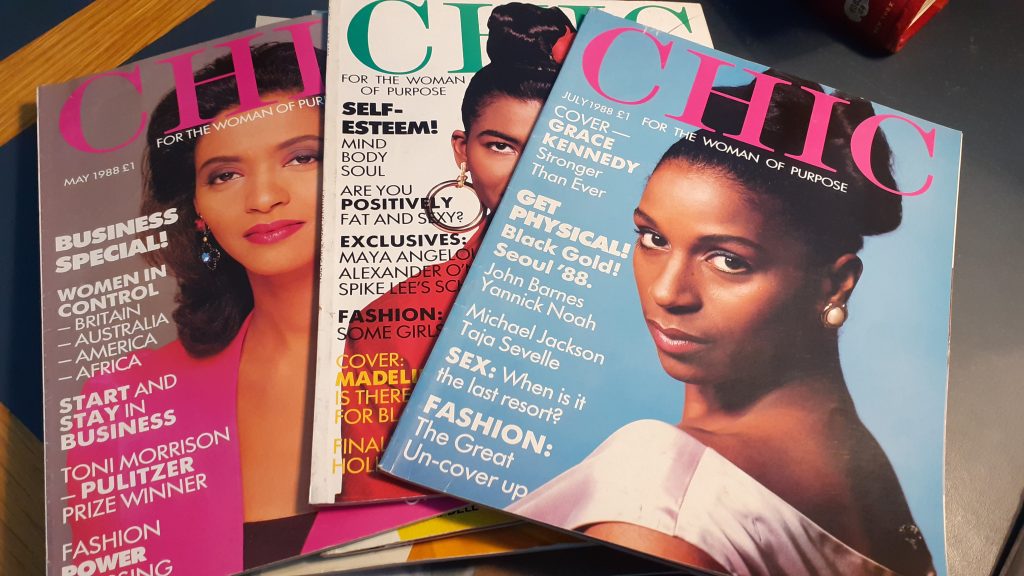by Daisy Payling
British women’s magazines are one of the source bases for our research on the Body, Self and Family project. They contain a wealth of material on the cultural framing of women’s experiences, but present a problem when trying to research and write an intersectional history of women’s bodily, emotional and psychological health as, from the 1960s to the 1990s, mainstream publications were predominantly aimed at white, heterosexual women and overwhelmingly featured white people on and between the covers.
To address this we are collecting oral history interviews with women born between 1940 and 1970, and are looking at magazines created by and for people of colour in the UK. Newspapers and journals for Britain’s Black and Asian communities multiplied from the 1960s onwards. The 1980s was a ‘decade of expansion’ for Black publishing in particular with emerging titles reflecting an ‘increasing slant towards consumerism rather than intellectualism’.[1] Within this turn came a number of magazine publications aimed at black British women who, until then, had had to rely on African American magazines such as Ebony and Essence to read about black women’s lives with any regularity. In the early 1980s, two magazines emerged which catered to black women in Britain; Black Beauty and Hair in 1982 and Chic in 1984. Black Beauty and Hair is Britain’s longest running glossy magazine for black women. Although initially focused on hair and beauty, it developed over decades to cover beauty, health updates, new products, horoscopes, celebrity interviews and articles – and it is still running today.[2] Chic swiftly followed Black Beauty and Hair and from the outset more closely emulated mainstream magazines, covering lifestyle, relationships, careers and beauty, from the perspective of black British women.[3]

Chic discussed race and gender discrimination and did not shy away from political topics; with articles on racism in the NHS (October 1987), black women and feminism (June/July 1986), the role of women in the pornography industry (October 1987), and struggles faced by young black undergraduates (January 1985). Its regular feature ‘Nelson’s Column’ provided a black male perspective on a range of topics including sex and relationships, and its regular ‘Personalities’ section and occasional ‘Woman to Woman’ feature gave space to in-depth interviews with global celebrities like Tina Turner and Anita Baker, and prominent British figures like Diane Abbott – who was interviewed twice (October 1985; September 1987).
Like many magazines Chic was also a site of advice. The magazine’s agony aunt page ‘Chic Counsel’ answered problems about dealing with a friend’s boyfriend trying it on, managing painful periods, interracial friendships, and gave one worried young woman the contact details for the Black Lesbian Support Network and the phone number for Lesbian Line. The magazine also included hair and beauty advice, alongside glossy colour adverts for hair products and smaller black and white adverts for local hair salons. In the early years of the magazine, information about salons for Afro and textured hair was collated into a ‘salon checklist’ near the back of the magazine. Salons were grouped by location, with names, addresses and telephone numbers organised under the headings of South London, Central London, North London, East London, Middlesex, Birmingham, Manchester, Northants, Leeds, Leicester and Glasgow (October 1984). These listings provided valuable information for women living in these areas and for those who may have needed to travel to get their hair styled. In Don’t Touch My Hair, Emma Dabiri recalls travelling from Dublin, Ireland to Tottenham in north London to get her hair done in the early 1990s.[4] In a pre-internet world, magazines could ease the spread of information beyond immediate local and community networks.
After Chic’s demise, Candice emerged to fill a gap in the market in the late 1980s. Billed as a magazine for ‘Today’s Black Woman and Family’ it was concerned largely with themes of self-improvement and cultural roots, and claimed a readership of 25,000. It emulated classic women’s magazine features such as beauty columns, letters pages and an agony aunt advice column, and covered a range of health topics including; pregnancy, natural childbirth and birth control, female circumcision, sickle cell and family health. With the help of local authority grants, editor Rasheda Ashanti ran Candice sporadically between 1989 and 1996. Kadija Sesay suggests that by the 1990s it was becoming clear that the market for Black publications was not large enough to support the sales of the numerous small publications which had emerged.[5] In the early 1990s, a glossy magazine called Pride emerged with backing from experienced staff at Voice – Britain’s largest selling Black newspaper – and began building a readership. Glossy, informative and investigative, Pride soon dominated the market, claiming readership figures of 200,000 in the late 2000s.[6]
If you read any of the magazines
mentioned here, or any other magazines aimed specifically at black women we
would love to hear from you. You can get in touch with us at admin@bodyselffamily.org.
[1] Kadija Sesay, ‘Publishing, newspapers and magazines’ in Alison Donnell (eds.), Companion to Black British Culture, (Routledge: London, New York, 2002), 250.
[2] Yinka Sunmonu, ‘Black Beauty and Hair’, in Donnell (eds.), Companion to Black British Culture, 39-40.
[3] Yinka Sunmonu, ‘Chic’, in Donnell (eds.), Companion to Black British Culture, 73.
[4] Emma Dabiri, Don’t Touch My Hair, (Penguin: Great Britain, 2020), 23.
[5] Kadija Sesay, ‘Publishing, newspapers and magazines’, 251-2.
[6] Yinka Sunmonu, ‘Pride’, in Donnell (eds.), Companion to Black British Culture, 245. Uchenna Izundu, “A fall in store for Pride?””. The Guardian. 8 January 2007 (accessed: 20 May 2020).

